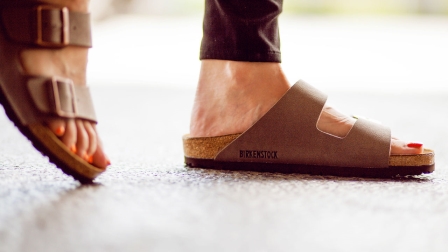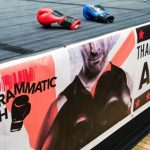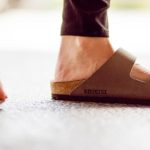How Birkenstock Stays In Vogue Without Selling Out
“It happens every several years,” says David Kahan, CEO of Birkenstock USA, the American division of the German company. “The planets line up and Birkenstocks become fashionable again.”
Perhaps because Mercury, Jupiter, and Saturn are all currently in retrograde, we’re currently experiencing one of these auspicious periods right now.
Almost against their will, fashion magazines are admitting that Birkenstocks are having a moment. In May, Vogue published a story featuring a paparazzi shot of Ashley Olson in a pair of Birkenstock Gizeh sandals and described the brand as “patient zero of the current ugly shoe movement.” (Several members of Vogue‘s staff chimed in saying they “remain unapologetic” about their loyalty to Birkenstocks.) Who What Wear reluctantly offered a shortlist of the brand’s least offensive styles for the sake of readers who were clamoring for guidance. “Most of us in the fashion world assumed the ugly-chic sandals would have a moment in the sun then fade into nothingness,” the writer says. “Well, as much as it pains us to admit it, we were very wrong.”
The last time Birkenstock made such a big splash in the glossies was four years ago, when Céline’s fashion show featured mink-lined Birkenstock sandals and Giambattista Valli created metallic studded pairs. Two decades before this, Kate Moss was styled in a 1990 The Face spread wearing Birkenstock sandals while holding a cigarette with ennui. In 1992, Marc Jacobs included the shoes when he was designing the infamous Perry Ellis grunge look.

Weathering Fashion’s Whims
In between these fashion peaks, Birkenstocks are regularly found on the feet of people who do not typically consider themselves stylish: crunchy, outdoorsy types in Berkeley, practical grandmas who want proper orthopedic support, German tourists who occasionally wear socks with their sandals. As Birkenstocks go from a must-have item one season to footwear that the chic wouldn’t lay a toe on the next, how does the company handle these ebbs and flows?
“Birkenstocks have a 240-year history of comfort and high quality. We realize that we’re just stewards of this brand,” Kahan says. “I don’t care about the next seven days or the next seven weeks. I care about the next seven years. Here, we don’t say, ‘Oh my God, fashionable people are now wearing us! How quickly can we become a fashion brand?’ We do just the opposite: We hold tight to the DNA of the brand.”
As a company that was founded a century before Vogue magazine came into existence, Kahan says he is more interested in ensuring that Birkenstock stays true to loyal fans than pandering to fickle fashionistas. This means, above all, not compromising comfort for style.
Following the philosophy of founder Konrad Birkenstock, who was an orthopedic authority in his time, the company has always focused on creating shoes that ensure the foot is well-supported, with an innovative footbed that molds to the wearer. Since looks were secondary in the beginning, the shoes have consistently appealed to people who value function over form. “Their love of the product leads to an emotional connection with the brand,” Kahan says. “People care a lot more about quality and comfort than we think they do.”
When Birkenstocks have bubbled up in the fashion world, it’s because fashion itself had shifted to accommodate the sandals’ aesthetics (see: 1995 grunge or 2014 normcore), not the other way around. And even when Birkenstocks are in, fashion magazines express ambivalence, all but holding their nose when writing about them. (The French call them jolie laide, which means “pretty ugly.”)
Trying On Trends
Still, Kahan thinks it is possible for Birkenstock to capitalize on trends without selling out. “It’s not like we’re scared of these fashionable people because they’re new to us and we don’t understand them,” he says. “We take these moments as a launching pad to take the brand to places it hadn’t been before. These new audiences can discover what longtime fans of the brand have known all along: The shoes feel great when you wear them.”
Over the last five years, Birkenstock has gotten into a groove of responding to what is happening in fashion by developing limited edition styles. The company is careful never to change any aspect of the footbed, which is the most distinctive and beloved part of the shoe, but they do unveil new colors and patterns regularly. This summer, they’ve put fresh spins on their classic styles. The Madrid, a one-strap slide sandal, now comes in a sparkly silver and a series of neons. The two-strap Arizona comes in floral prints. The Gizeh thong now comes in black patent and a shimmery snakeskin. “These are the same textures and colors that we’re seeing in [high-fashion] ready-to-wear,” Kahan says.
To market these trendier products, Birkenstock launches campaigns that help potential customers style the shoes in new ways. They’ll present the sandals on models wearing skinny jeans or leather jackets, sending the message that the shoes are not just for granola-eating hippies and they can complete any outfit. “We’re not leaving behind the traditional Birkenstock consumer, but the same shoe is now ending up in the closet of a woman who might have Jimmy Choos or Manolo Blahniks,” Kahan says. “We’re not changing anything about ourselves per se, but we’re connecting with a new consumer.”
And they appear to be hitting the mark. On a recent walk through New York City’s West Village and Tribeca neighborhoods, I noticed the streets were flooded with women sporting of-the-moment jumpsuits and culottes with Gizehs and other Birkenstock models. The sandals have also become popular with celebrity moms, as the tabloids have amply documented with photographs of Julianne Moore, Gwyneth Paltrow, Heidi Klum, and Naomi Watts all wearing them.
Kahan says that Birkenstock keeps a very careful hold on where the shoes are distributed to ensure that they are sold at fashionable top-tier retailers like Barney’s or SoHo boutiques. This maintains Birkenstock’s reputation as a premium brand, but it also places the name alongside more trendsetting labels. At a price of between $69 and $99, Kahan points out that Birkenstocks are much cheaper than other brands on the luxury shoe floor, like Manolo Blahniks or Christian Laboutins.
Stay True To Your Base
No matter what new colors or textures Birkenstock tries on for size, it always stocks the classic black, brown, and taupe leathers for loyal customers looking for predictability. And while the shoes are sold in hipster neighborhoods, they’re also found in traditional orthopedic stores. “We will never compromise on the function of the shoe,” Kahan says. “We’re not chasing fashion: We’re just refreshing styles in the same models we have always had.”
Personally, I’d never been particularly interested in Birkenstocks. I couldn’t pull off the normcore look and before that, grunge wasn’t my thing. But as a new mom, I’ve been in search of a pair of comfortable shoes that I could slip on and then rush around town, often with my child strapped to me in my Baby Björn. I tried my first pair as I was writing this story, and the soft footbed that provided remarkable support was a welcome change after a lifetime of destroying my poor feet with flats and high heels with zero arch support. The sleeker models—like the black Gizehs—look great with sundresses, pencil skirts, and slim jeans. I’m not surprised that Birkenstocks are now all the rage among Park Slope moms.
Kahan is hoping that the recent fascination with Birkenstocks will introduce people like me to the shoes and that we’ll be so hooked by the comfort that we’ll continue wearing them long after the fashion magazines turn against them again, as they inevitably will.
“There’s no scientific way to predict fashion cycles,” Kahan says. “But what we do with these moments can help us set up the future of the brand.”
Fast Company , Read Full Story
(57)










